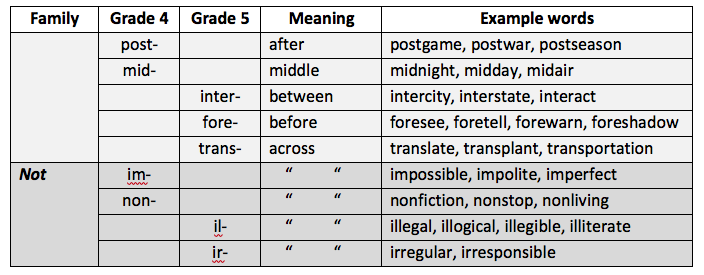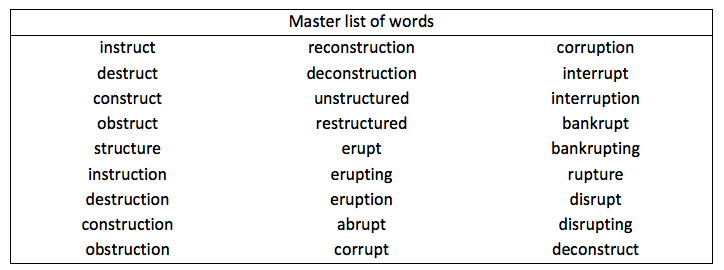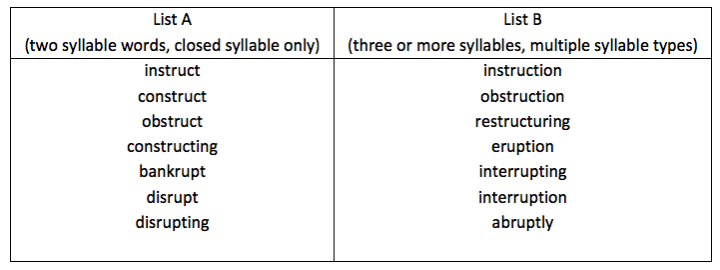|
You may have heard that “In primary grades, kids learn to read, and in upper grades, kids read to learn.” It’s a cleverly constructed saying, but it’s not true. Children in all grades do both. So, if you’re a middle school teacher focusing on using text to convey information (reading to learn), you can also help your students learn to read. One practical way to help middle grades students improve their reading skills is to provide direct and explicit spelling instruction. Did you know spelling is for reading? It’s true! Spelling instruction helps students store the correct letter sequences of words in their “brain dictionary.” Once a word is stored, it is available for reading as well as for writing. To read, children (and adults) make use of the sounds, meanings, and spellings of words resident in their brains. The three elements – sound, meaning, and spelling – interconnect through brain circuits that bring about reading. Morphology is the fancy word for studying the meaning-making parts of language. Younger children will be exposed to simple letters, like the letter “s,” which in the word forks means more than one. For middle grades students, one logical way to connect spelling to sound and meaning is through syllables, the “chunks” of spoken and written language. Spoken or “audiated” syllables are encoded when students spell words in writing. Conversely, written syllables are decoded into sound during reading. In the upper grades, syllables often take the form of prefixes, suffixes, and Greek and Latin roots. Middle school kids see them all the time in English, History, Science, and Geography. When you help students understand the meaning of syllables, be they affixes or roots, you connect spelling instruction to reading and vocabulary. Wow – talk about synergistic, powerful teaching! Common chunks taught by category What spelling syllables should be taught in middle school? Here are three suggestions. The first two are based on fascinating work done by reading researchers Patrick Manyak, James Baumann, and Ann-Margaret Manyak. The third is featured in my spelling resource book, Super Speller Starter Sets.
Let’s start by considering some prefixes that mean “not.” According to researchers, the prefixes im-, non-, il- and ir- appear frequently in text. So teach them, perhaps grouping them two at a time. Do the same for post, mid, inter, and fore, which are commonly occurring and united by their relationship to position. Treat Greek and Latin roots similarly. Charts are adapted from Patrick C. Manyak, James F. Baumann, Ann-Margaret Manyak, Morphological Analysis Instruction in the Elementary Grades: Which Morphemes to Teach and How to Teach Them, The Reading Teacher, 72, 3, (289–300), (2018). Differentiating Spelling instruction is stronger when it is focused. So consider teaching just three spelling patterns per week, rather than five or six. Spelling instruction is also more powerful when it supports a variety of achievement levels. So, rather than giving the same spelling list to all students, create two lists, thus providing options. A focused but rich master list, containing many words built from only a few patterns, is a good way to go. I discuss the idea of the master list in my books Super Spellers and Super Speller Starter Sets, and in previous posts on this blog. Above is a master list of words built from two Latin roots: rupt (break) and struct (build). Because these roots are commonly occurring and thematically related, teach them together. To get at the meaning of words, you’ll have to touch upon the meanings of additional prefixes and suffixes (-tion, un-, de-, in-, con-, dis-), but these won’t be the focus of your instruction. The main focus is word meaning that flows from the roots rupt and struct. Finally, differentiate your list based on the number and type of syllables in each word. Two-syllable words are less complex than three-syllable words. Likewise, words made from only one or two syllable types are less complex than words made from many syllable types. Here are two spelling lists that vary in complexity The words in your master spelling list can be used for phonics and vocabulary lessons, too. Here are some activity ideas:
Spelling deserves instructional time
Even in middle school, students are still learning how to read. Because spelling is for reading (as well as writing), spelling is an important part of the instructional day. When you find it difficult to find enough time to teach everything, think of how spelling, vocabulary, and reading overlap. By conceptualizing spelling instruction as a way to also teach decoding and vocabulary, you can be both efficient and effective. This blog post first appeared as an article published in MiddleWeb (07/09/2019) https://www.middleweb.com/40587/spelling-matters-in-middle-school-too/ |
Mark WeaklandI am a teacher, literacy consultant, author, musician, nature lover, and life long learner.
|





 RSS Feed
RSS Feed